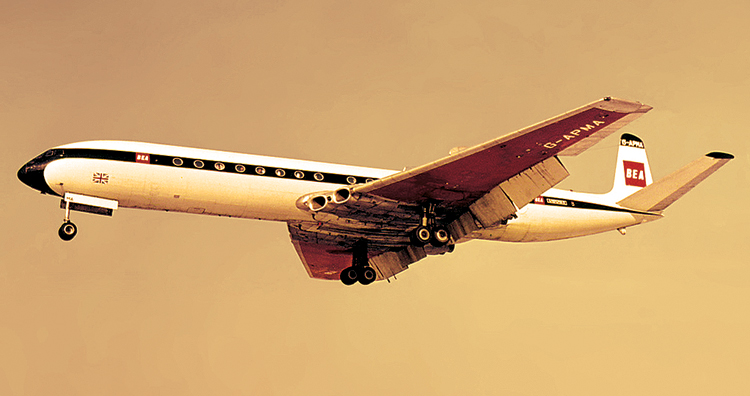INDIAN ARMED FORCES CHIEFS ON
OUR RELENTLESS AND FOCUSED PUBLISHING EFFORTS

SP Guide Publications puts forth a well compiled articulation of issues, pursuits and accomplishments of the Indian Army, over the years

I am confident that SP Guide Publications would continue to inform, inspire and influence.

My compliments to SP Guide Publications for informative and credible reportage on contemporary aerospace issues over the past six decades.
DH 106 Comet — The World’s First Jet Airliner
The Comet paid the price for being the first commercial jet as it encountered the inevitable pitfalls which other manufacturers took note of and remedied

The first flight of a turbojet-powered manned aircraft, a Heinkel He 178, took place in Germany on August 27, 1939. During World War II, the focus was naturally on military jets. The United States soon took and retained its lead in jet technology ever since. Yet, it was in the United Kingdom that the first commercial jet airliner emerged. Aviation company de Havilland challenged the then widely held scepticism about the suitability of jet engines for commercial aviation and proposed a pure turbojet design to the British government.
The de Havilland DH 106 Comet prototype first flew on July 27, 1949. It was an all-metal, low-wing, cantilever monoplane featuring several elements that were fairly innovative for the period. It was powered by two pairs of de Havilland Ghost 50 Mk1 turbojet engines buried in the wing roots. The engines were economical in operations above 30,000 feet.
The state-owned British Overseas Airways Corporation (BOAC) operated the Comet on its first scheduled flight on May 2, 1952, on the London to Johannesburg route. The flight via Rome, Beirut, Khartoum, Entebbe and Livingstone took just over 23 hours and was an unqualified triumph. The propeller-powered airliners of the time had to fly low due to their unpressurised cabins and were rather uncomfortable and noisy. They often encountered turbulence as they tried to dodge bad weather. In contrast, the Comet offered a relatively quiet and vibration-free journey from its cruising altitude of almost 40,000 ft. Its large rectangular picture windows gave passengers a stunning view of the Earth below. No other airliner boasted of a galley that served hot and cold food and drinks, a bar, and separate men’s and women’s toilets. And all this luxury came at the same ticket price as BOAC’s piston-engine aircraft, since the Comet needed only 43 per cent load factor to be commercially viable. In the first year of operation, Comets carried 30,000 passengers and airliner sales were growing. All indicators pointed towards commercial success while aviation analysts opined that Britain had stolen a vital march of three to five years over the rest of the world in jet airliners.
However, disaster struck on March 3, 1953, when a Canadian Pacific Airlines Comet 1 failed to get airborne while attempting a night takeoff from Karachi. All five crew and six passengers on board were killed, making this the first fatal crash of a jet airliner. On May 2, 1953, BOAC Flight 783 broke up in mid-air shortly after takeoff from Kolkata killing all 43 passengers and crew. It was presumed that squally weather was the root cause. On January 10, 1954, BOAC Flight 781 crashed into the sea off the Italian coast, killing all 35 on board. All Comets were grounded and an investigation was conducted.
Since planes did not have flight data or cockpit voice recorders, investigators had to figure out what had happened purely from the physical evidence. The ruptured lungs of many passengers were a sure indicator that the cabin had experienced an explosive decompression at altitude. However, the Comet project was crucial for the success of the British aerospace industry and BOAC. Hence, after some modifications that were carried out, the airliner was declared safe and flights resumed within just ten weeks on March 23, 1954. This decision quickly proved fatal, because on April 8, 1954, South African Airways Flight 201 on a flight from Rome to Cairo, crashed into the Mediterranean with the loss of all 21 on board. The Comet fleet was grounded once again.
This time, the investigation was much more thorough and prolonged and investigation into the similar accident in January was reopened. After intense testing, investigation revealed two serious design defects. First, the constant stress of pressurisation and depressurisation at high altitudes could weaken an area of the fuselage around the Comet’s rectangular windows. Secondly, the skin of the aircraft had been made as thin as possible to save weight. Hence metal fatigue in the airframe, a phenomenon not fully understood at the time, could ultimately result in explosive decompression and structural failure.
The airliner had to be extensively redesigned and resumed flying only after four years as the Comet 4. However, by then the American Boeing 707 and Douglas DC-8 jets had captured the market. They were larger, faster, had better range and were more cost-effective than the Comet. An experienced Comet pilot Peter Duffey said ruefully of the Comet 4: “It was a super aircraft. It was beautiful to fly and land, but it was too late.” The Comet paid the price for being the first commercial jet as it encountered the inevitable pitfalls which other manufacturers took note of and remedied. But jet airliner travel became that much safer because of it.





